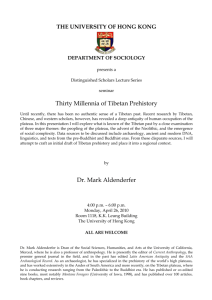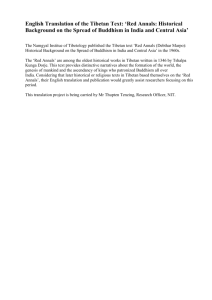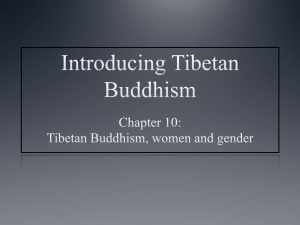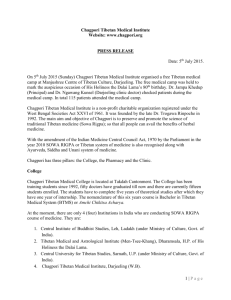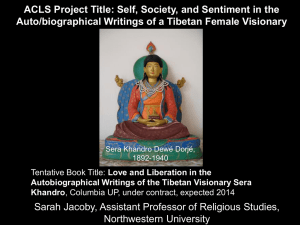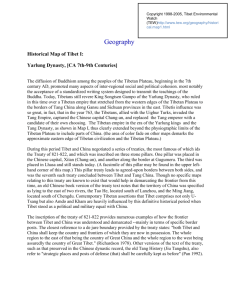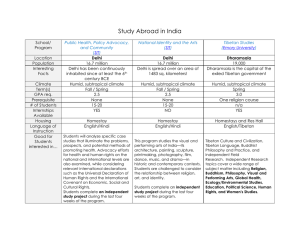Methods, Meanings, and Representations in the Study of Past Tibetan Societies
advertisement
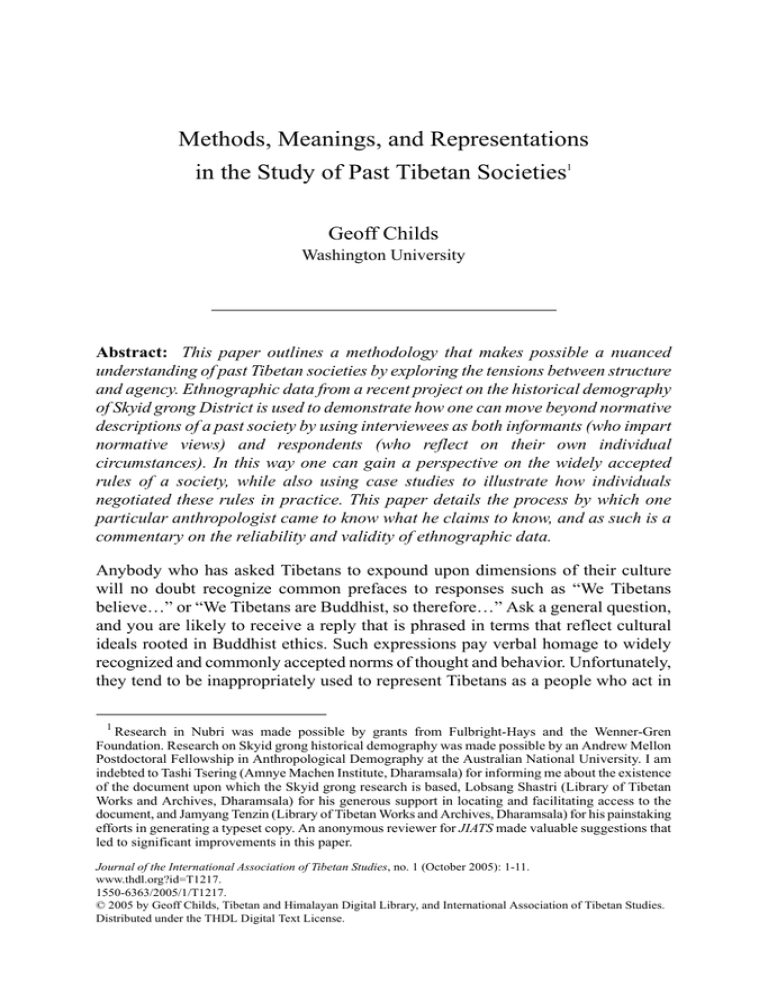
Methods, Meanings, and Representations in the Study of Past Tibetan Societies1 Geoff Childs Washington University Abstract: This paper outlines a methodology that makes possible a nuanced understanding of past Tibetan societies by exploring the tensions between structure and agency. Ethnographic data from a recent project on the historical demography of Skyid grong District is used to demonstrate how one can move beyond normative descriptions of a past society by using interviewees as both informants (who impart normative views) and respondents (who reflect on their own individual circumstances). In this way one can gain a perspective on the widely accepted rules of a society, while also using case studies to illustrate how individuals negotiated these rules in practice. This paper details the process by which one particular anthropologist came to know what he claims to know, and as such is a commentary on the reliability and validity of ethnographic data. Anybody who has asked Tibetans to expound upon dimensions of their culture will no doubt recognize common prefaces to responses such as “We Tibetans believe…” or “We Tibetans are Buddhist, so therefore…” Ask a general question, and you are likely to receive a reply that is phrased in terms that reflect cultural ideals rooted in Buddhist ethics. Such expressions pay verbal homage to widely recognized and commonly accepted norms of thought and behavior. Unfortunately, they tend to be inappropriately used to represent Tibetans as a people who act in 1 Research in Nubri was made possible by grants from Fulbright-Hays and the Wenner-Gren Foundation. Research on Skyid grong historical demography was made possible by an Andrew Mellon Postdoctoral Fellowship in Anthropological Demography at the Australian National University. I am indebted to Tashi Tsering (Amnye Machen Institute, Dharamsala) for informing me about the existence of the document upon which the Skyid grong research is based, Lobsang Shastri (Library of Tibetan Works and Archives, Dharamsala) for his generous support in locating and facilitating access to the document, and Jamyang Tenzin (Library of Tibetan Works and Archives, Dharamsala) for his painstaking efforts in generating a typeset copy. An anonymous reviewer for JIATS made valuable suggestions that led to significant improvements in this paper. Journal of the International Association of Tibetan Studies, no. 1 (October 2005): 1-11. www.thdl.org?id=T1217. 1550-6363/2005/1/T1217. © 2005 by Geoff Childs, Tibetan and Himalayan Digital Library, and International Association of Tibetan Studies. Distributed under the THDL Digital Text License. Childs: Methods, Meanings, and Representations in the Study of Past Tibetan Societies 2 strict accordance with religious principles, a caricature that has not held up well to critical scrutiny.2 To put it bluntly, we should never assume that statements reflecting acceptable standards of behavior are an infallible guide to how people think and act under concrete circumstances. A vignette from my fieldwork in the ethnically Tibetan enclave of Nubri, Nepal, can help illustrate this point.3 We all know that Buddhist philosophers espouse a rather dim outlook on the taking of life. To circumvent the ethical prohibition on killing, Tibetans rely on a special class of butchers who accrue the sins resulting from slaughtering sentient beings so that other members of the community can consume meat free from consequences. But what happens in Buddhist societies such as Nubri where there are no butchers? Whenever I encountered men coming from a nearby pasture carrying bamboo baskets laden with chunks of a freshly dismantled bovine carcass, they would invariably point to the precipice below the grazing grounds and say, “My yak fell off the cliff and died.” Then one day a neighbor began to inquire about my host’s food supply. When he heard that we were down to roasted barley flour (rtsam pa) and cured lard (tshi lu), his eyes lit up and he divulged, “One of my yaks is going to fall off a cliff tomorrow. Are you guys in for a quarter?” We leapt at the opportunity to replenish our larder with something other than carrion and promptly drew lots. The next day we were given the right fore-quarter of a yak that, at the time of the lottery, had been walking about blissfully unaware that it was slated to take a tumble. This digression illustrates how Tibetans in Nubri use a semantic device to sidestep the issues of human agency and premeditated intent. My neighbor made the explicit claim that the animal died as a result of its own ambulatory incompetence, rather than admitting that he had dispatched it with a skillfully guided knife. He invoked the claim, “my yak fell off a cliff,” in an effort to dissociate his own actions from karmic repercussions, and perhaps also to deflect moral rebukes from clerics and fellow villagers. Killing is certainly considered reprehensible in this devoutly Buddhist community, but starvation is not a very attractive option either. The moral of the story is that cultural ideals often conflict with the realities of everyday existence. Culture guides but does not predetermine an individual’s thoughts and actions. The purpose of this paper is to engage in a methodological discussion centering on the interplay between cultural ideals and individual actions. Much of what I write is not new to anthropologists for whom the issues of structure and agency have been prominent in theoretical circles for decades. Nevertheless, while working in an interdisciplinary chasm flanked by a highly reflexive qualitative discipline 2 Toni Huber, “Green Tibetans: A Brief Social History,” in Tibetan Culture in the Diaspora, ed. Frank J. Korom (Wien: Verlag der Österreichischen Akademie der Wissenschaften, 1997), 103-19; Donald S. Lopez, Prisoners of Shangri-La (Chicago: University of Chicago Press, 1998); and Thierry Dodin and Heinz Räther, eds., Imagining Tibet: Perceptions, Projections, and Fantasies (Boston: Wisdom, 2001). 3 This vignette originally appeared in Geoff Childs, Tibetan Diary: From Birth to Death and Beyond in a Himalayan Valley of Nepal (Berkeley: University of California Press, 2004), 126-28. Journal of the International Association of Tibetan Studies 1 (October 2005) 3 (anthropology) and a hyper-positivistic quantitative discipline (demography), I have been confronted with the reality that anthropologists are not always adept at convincing other scholars that our findings are valid. Part of the problem stems from the fact that anthropologists tend to be less than forthright when it comes to explicating procedures for gathering and analyzing data, and as a result our methods are seen by many as slip-shod at best, and esoteric or even arcane at worst. Too often anthropologists divulge little beyond the approximate place where they worked, the number of months spent “in the field,” and perhaps some casual references to the use of participant observation or in-depth interviews. Under these circumstances it is nearly impossible to assess how an anthropologist went about gathering the very data that is used to construct representations of Tibetan societies. The theme of this paper centers on how we come to know what we claim to know.4 Reliability, Validity, and Objectivity Objectivity is a concept that has been subjected to a thorough flogging in anthropology following the rise of postmodernist epistemologies. Although I appreciate many of the lessons that derive from hermeneutic and interpretivist perspectives5 and concur that true objectivity is an unattainable goal, I remain committed to the idea that general principles can be induced from particular facts. To further this intention I turn to a qualified definition of objectivity that is quite useful for analytical purposes. Kirk and Miller define objectivity as “the simultaneous realization of as much reliability and validity as possible.” Reliability is “the extent to which a measurement procedure yields the same answer however and whenever it is carried out” or “the degree to which the finding is independent of accidental circumstances of the research.” Validity is “the extent to which it [research and analysis] gives the correct answer” or, stated in another way, “the degree to which the finding is interpreted in a correct way.”6 The issue of objectivity arises in various guises with respect to representations of past Tibetan societies. Elliot Sperling7 provides us with an appropriate illustration. In a critique of some facile portrayals of Tibetan society, he cites a letter written 4 A slight disclaimer is in order. Anthropology is a discipline characterized by diverse epistemologies and methods. In no way do I imply that every anthropologist relies on methods similar to those described in this paper. Nor do I suggest that the particular approach outlined here is somehow superior to the methods used by other anthropologists. We all choose particular research strategies based on a combination of theoretical orientations and realities encountered in the field. Nevertheless, I do maintain that a bit more methodological rigor and transparency can only benefit our discipline, especially if we aspire to appeal to scholars in other disciplines. 5 James Clifford and George E. Marcus, eds., Writing Culture: The Poetics and Politics of Ethnography (Berkeley: University of California Press, 1986); and James Fernandez and Michael Herzfeld, “In Search of Meaningful Methods,” in Handbook of Methods in Cultural Anthropology, ed. H. R. Bernard (Walnut Creek, CA: Alta Mira Press, 1998), 89-129. 6 Jerome Kirk and Marc L. Miller, Reliability and Validity in Qualitative Research (Thousand Oaks, CA: Sage, 1986), 9-21. 7 Elliot Sperling, “‘Orientalism’ and Aspects of Violence in the Tibetan Tradition,” in Imagining Tibet: Perceptions, Projections, and Fantasies, ed. T. Dodin and H. Räther (Boston: Wisdom, 2001), 317-30. Childs: Methods, Meanings, and Representations in the Study of Past Tibetan Societies 4 in 1662 by the Fifth Dalai Lama instructing Gushri Khan to exterminate rebellious Tibetans and their families. He uses the Fifth Dalai Lama’s advocacy for violent measures to argue, [W]e can in fact find modern writers projecting current ideas concerning the nonviolence associated with the present Dalai Lama back onto previous Dalai Lamas. This in turn makes it seem as if nonviolence of the Gandhian sort were one of the basic hallmarks of Tibetan Buddhism in general, not only in the religious and philosophical sphere, but in the political sphere as well.8 Sperling’s point relates to my argument that cultural ideals do not necessarily correlate with actions. Buddhism is a religion that emphasizes nonviolence – there is little to debate about this point. Therefore, the claim that Buddhism is a religion that advocates nonviolence is a valid statement based on consistent (reliable) evidence found in scriptures and teachings by clerics. However, the evidence brought forth by Sperling demonstrates that the current Dalai Lama has been more unwavering in his advocacy for nonviolence than some of his predecessors. To project the Fourteenth Dalai Lama’s principles back in time is to allege that all Dalai Lamas acted in perfect accord with their religious ideology – an invalid conclusion that is contradicted by evidence penned by the Fifth Dalai Lama himself. The next example illustrates how another representation of the Tibetan past suffers from problems of reliability and validity. Much has been written about the remarkable rise of monasticism and the flourishing of intellectual culture in Tibet following the Fifth Dalai Lama’s ascent to power. However, not all depictions of monastic culture are valid. For instance, one scholar claims, “[monasteries in post-seventeenth century Tibetan society] were voluntary mechanisms of population control.”9 At face value, this statement seems unproblematic because the removal of numerous individuals from the reproducing segment of society can negatively impact population growth. However, the statement is based on conjecture and not evidence. Despite claims to the contrary, we are currently ignorant about the size of the Tibetan population at past times. Due to the dearth of reliable data we have no basis to judge whether the population was increasing, decreasing, or stable at any point in history.10 Therefore we are in no position to draw conclusions about the impact that monasticism had on vital demographic rates. Furthermore, the supposition that monasteries were “voluntary mechanisms of population control” can only be validated by evidence that these institutions were established for that purpose in the first place, or by evidence that individuals entered monasteries with the conscious intent of restraining population growth. To my knowledge, no such evidence exists. Even if the practice of relegating high numbers of men to lives of 8 Sperling, “Orientalism,” 319. 9 Robert Thurman, “Tibetan Buddhist Monasticism and Intellectual Culture,” in White Lotus: An Introduction to Tibetan Culture, ed. C. Elchert and P. Sugden (Ithaca: Snow Lion Publications, 1990), 110. 10 See Geoff Childs, “Polyandry and Population Growth in a Historical Tibetan Society,” The History of the Family 8, no. 3 (2003): 423-44. Journal of the International Association of Tibetan Studies 1 (October 2005) 5 celibacy did depress the birth rate in Tibet (which is not necessarily a valid conclusion since female celibacy exerts far more influence on birth rates than male celibacy), claiming that population control was a primary intent of monasticism and not just an unintended (but perhaps not unappreciated) outcome remains an invalid conclusion until evidence is presented to demonstrate the causal connections. These two examples are used to demonstrate that representing past Tibetan societies is an endeavor that is permeated with uncertainty and subjectivity. Nevertheless, I maintain that we can do a better job by adhering to some methodological principles and by keeping an eye on the issue of objectivity as it has been defined above. The paper will now turn to methods that can enhance our understanding of the interactions between cultural ideals and individual agency. A Research Dilemma Dargyay, who documented many details of traditional village life in Tibet through retrospective interviews, alludes to a research predicament which is central to this discussion: Of course, there are and were a lot of contradictory facts to be met within the Tibetan society, and not every Tibetan was inclined to base his life on religious concepts and ideals. Thus the above rendered image [of a particular Tibetan society] fails to convey the normative thinking outside religion. This is simply due to the lack of information. As are most people, Tibetans too are fond of depicting themselves as pious, law-abiding, and hard-working people. Though only a part of the whole population had really shared this opinion, they would never have told about their diverging inclinations to a foreigner.11 In contemporary settings, data obtained through interviews can be supplemented with the first-hand witnessing of events as they unfold in context (i.e., participant observation), and with follow-up interviews to probe the thoughts and motivations that guided an individual’s actions during the observed event. Unfortunately, such a triangulation strategy is not feasible when studying a past that is impossible to witness in person. Therefore, Dargyay’s observation begs the question – how do we gain a nuanced perspective on a society that can only be documented through archival records and the selective recollections of living informants? Although I agree with Dargyay’s point that Tibetans tend to present normative views of their society, “diverging inclinations” are certainly not beyond the grasp of foreign researchers. To be fair, Dargyay is not the only scholar who was unable to penetrate the veil of normative statements and reveal cultural contradictions that arise in the course of everyday experience.12 At least she was forthright in 11 12 Eva M. Dargyay, Tibetan Village Communities (New Delhi: Vikas, 1982), 52. See, for example, C. W. Cassinelli and Robert Ekvall, A Tibetan Principality: The Political System of Sa-skya (Ithaca: Cornell University Press, 1969); Franz H. Michael, Rule by Incarnation: Tibetan Buddhism and Its Role in Society and State (Boulder, CO: Westview Press, 1982); and Anne Hubbell Maiden and Edie Farwell, The Tibetan Art of Parenting: From Before Conception Through Early Childhood (Boston: Wisdom Publications, 1997). Childs: Methods, Meanings, and Representations in the Study of Past Tibetan Societies 6 acknowledging this problematic dimension of her research. There are methods that can be used to overcome this problem. Variations of life history analysis, which involves the narrative study of lives to flesh out the details of lived experiences in relation to social norms and expectations,13 were used by both Goldstein14 and Aziz15 to underscore the agency that people have in negotiating their way about seemingly rigid social structures. Another way to probe the interplay between cultural ideals, social expectations, and individual agency is through “person-centered interviewing”16 in which the researcher treats the interviewee as both an informant and a respondent. As an informant (key informant in the classical anthropological sense), the person is asked to describe general cultural principles and practices – the “we Tibetans believe” approach – that helps identify commonly accepted rules of a society. As a respondent, the same person is asked to describe personal experiences that transpired in the social context of those normative rules. Careful analysis of interview data allows the ethnographer to explore how ideals are negotiated in practice. The benefits of using person-centered interviewing are highlighted in the following section. Deviations from the Norm? Or Deviations as the Norm? I will now turn to my own study of Skyid grong historical demography to provide fodder for the methodological discussion. Skyid grong was formerly a district-level administrative unit (rdzong) of Tibet bordering Nepal. My study of Skyid grong historical demography has been facilitated by the discovery of a household register (sgo khra them gan) that was compiled in 1958 for tax purposes.17 The document lists all 2845 government subjects in Skyid grong by village, household, name, age, and relationship within the household.18 In the course of my research I interviewed roughly 180 elderly exiles from Skyid grong. The overall objective of this ongoing project is to situate statistics derived from the household register within an ethnographic context in order to better understand the various processes that go into shaping demographic outcomes such as the fertility rate. To an extent this endeavor is an example of so-called “salvage ethnography,” and is similar in 13 Ruthellen Josselson and Amia Lieblich, eds., The Narrative Study of Lives (Newbury Park, CA: Sage, 1993); and Robert Atkinson, The Life Story Interview (Thousand Oaks, CA: Sage, 1998). 14 Melvyn C. Goldstein, “Reexamining Choice, Dependency and Command in the Tibetan Social System: ‘Tax Appendages’ and Other Landless Serfs,” Tibet Journal 9, no. 4 (1986): 79-112; and Goldstein, “Freedom, Servitude, and the ‘Servant-serf’ Nyima,” Tibet Journal 14, no. 2 (1989): 56-60. 15 Barbara Aziz, Tibetan Frontier Families (New Delhi: Vikas, 1978). 16 R. Levy and D. Hollan, “Person-Centered Interviewing and Observing,” in Handbook of Methods in Cultural Anthropology, ed. H. R. Bernard (Walnut Creek: Alta Mira Press, 1998), 333-64. 17 The full title of the text is Sa khyi lo’i skyid grong rdzong rgya dgu’i sgo khra them gan. For a description of the document and a discussion of demographic and ethnographic methods that were used to estimate fertility and population growth, see Geoff Childs, “Polyandry and Population Growth in a Historical Tibetan Society,” The History of the Family 8, no. 3 (2003): 423-44; and Childs, “Ethnographic and Demographic Analysis of Small Populations Using the Own-Children Method,” Field Methods 16, no. 4 (2004): 379-95 . 18 Childs, “Polyandry.” Journal of the International Association of Tibetan Studies 1 (October 2005) 7 nature to earlier works on Tibet published by Cassinelli and Ekvall,19 Goldstein,20 Aziz,21 and Dargyay.22 The purpose of salvage ethnography is to record details of a past society (i.e., Tibet prior to 1959) before all recollections disappear – a process that is well underway and depressingly near completion among Tibetans. During the very first interview of this project I asked several elderly men to discuss marriage. Without dissent, they replied that fraternal polyandry was universally practiced in Skyid grong. They also claimed that all women married. These statements represent cultural ideals, yet simple arithmetic brings the two proclamations into logical dispute (unless men far outnumbered women, which was not the case). Over the course of the next several months I relied on person-centered interviewing to better understand how the marriage system in Skyid grong worked in both theory and practice. To accomplish this objective I would first track down a former Skyid grong resident, locate that person’s name in the household register, and then interview them about various topics centering on the family and household. For example, here is how one household’s entry appears in the document: 2 rkang [the size of the taxable landholding]: Rgya mtsho, male head of household (’dzin mi khyo), age 61; Bsam gtan the brother (spun), age 51; Bkra shis the bride (mna’ ma), age 65; Phun tshogs the son (bu), age 27; Bu ’khrid the bride, age 47; Nor bu the son, age 19; Bzang mo the daughter (bu mo), age 15; Lhag pa the son, age 13; Rin chen the son, age 15.23 Bzang mo and Lhag pa were interviewed at their respective homes in Kathmandu and Dharamsala. Both reiterated the common refrain that polyandry was the preferred and normative marriage form among taxpayer (khral pa) households in Skyid grong, and that people considered it appropriate for all women to marry. However, when I probed into the details of this particular household some interesting facts emerged that tell us quite a bit more about Skyid grong society. True to custom the brothers Rgya mtsho and Bsam gtan took a common wife, Bkra shis. She only gave birth to a single son, Phun tshogs, who was mentally disabled. Under such circumstances the brothers were permitted to take a second joint wife. However, discord within the family led to a split. Rgya mtsho resided in a separate residence with Bkra shis and Phun tshogs, while Bsam gtan took a new spouse, Bu ’khrid, who bore two sons (Nor bu and Lhag pa) and a daughter (Bzang mo). 19 Cassinelli and Ekvall, Principality. 20 Melvyn C. Goldstein, “Stratification, Polyandry, and Family Structure in Central Tibet,” Southwest Journal of Anthropology 27 (1971a): 64-74; and Goldstein, “Taxation and the Structure of a Tibetan Village,” Central Asiatic Journal 15, no. 1 (1971b): 1-27. 21 22 Aziz, Families. Dargyay, Communities. 23 I did not receive permission to visit Skyid grong while undertaking this research. Nevertheless, I did not lack informants since a large proportion of the population slipped across the border into Nepal during the 1960s. Former residents of Skyid grong were interviewed in Nepal (Shebrubensi and Kathmandu) and India (Dharamsala and Pandoh). All the names have been changed since many of the people listed in the household register are still alive. Childs: Methods, Meanings, and Representations in the Study of Past Tibetan Societies 8 Rin chen was the son of neither of the wives, but was the illegitimate child of Rgya mtsho and Bsam gtan’s sister. A few years after giving birth she married a man who was not his father, and abandoned Rin chen with his uncles when she moved to her husband’s household. Another household is enumerated as follows: 3 rkang [the size of the taxable landholding]: Tshe dbang, head of household (’dzin mi), age 69; Dbang rgyal, age 57; Lha mo the daughter, age 38; Pad ma the bride, age 57; Phur bu the son, age 16; Mi ’gyur the son, age 26; Mchog pa the daughter, age 22; Pa sangs the son, age 3; Rdo rje the son, age 19. Mi ’gyur and Mchog pa were both interviewed in Pandoh, India. They revealed that Tshe dbang and his younger brother Dbang rgyal had taken Pad ma as their common wife. Contrary to first impressions, Lha mo was not their daughter but was the illegitimate child of Tshe dbang and Dbang rgyal’s sister who had departed (died?) this household by 1958. Lha mo was not sent by her uncles to be a bride in another household, but was retained as a caretaker for the aging brothers and their wife. Tshe dbang, Dbang rgyal, and Pad ma had three children of their own, the sons Phur bu and Mi ’gyur, and the daughter Mchog pa. In 1958 Phur bu and Mi ’gyur had not yet taken a common wife. Phur bu, however, carried on a relationship with a woman in the village that resulted in the birth of Pa sangs. Pa sangs was claimed by his father and raised in his household. These two examples alone show considerable variations in behavior from the norms of polyandry and universal marriage for women. In the interest of brevity no further households will be detailed here. To summarize some findings, I was able to document squabbles over resources that resulted when one brother in a polyandrous household decided to take his own wife; younger brothers in polyandrous households who willingly sacrificed the economic security of their households in order to reside with their own partners and have their own children; a woman who was sent away in marriage but ended up in prison when she refused to reside with her husband; women who did not marry due to a shortage of households, but who nevertheless bore illegitimate children; an unmarried woman whose illegitimate child was the result of a rape, and so forth. The initial proclamations made by my three elderly informants was a good starting point for a study of marriage and reproduction in Skyid grong, but was an insufficient foundation upon which to base meaningful conclusions. By employing the person-centered interviewing technique, the analysis could move beyond simplistic abstractions about an ideal family system. I noted the cultural ideals that were expressed consistently from interview to interview, but also uncovered departures from those ideals by systematically recording the minutiae of specific marriages, residential arrangements, illegitimate births, and so forth. The data reveals an assortment of constraints on individual choice, but also a myriad of opportunities that were open to individuals who did not choose to follow cultural prescriptions. Journal of the International Association of Tibetan Studies 1 (October 2005) 9 I will now summarize some logical progressions from the analysis of data to the formulation of conclusions. When elderly people from Skyid grong were interviewed as “informants,” they invariably responded that polyandry was the preferred marital form. The consistency of responses indicates that their answers are very reliable. However, when individual circumstances were explored by interviewing the same people as “respondents,” it became apparent that the normative statements do not translate very well into a model of how people actually acted under discrete circumstances. Polyandry was indeed nearly universal among taxpayer households. However, polyandrous marriages were unstable because many men, especially younger brothers, opted out in favor of residing with a partner of their own.24 Similarly, when people were interviewed as “informants,” they consistently stated that a woman’s ideal situation in life was to be married within a taxpayer household. This particular cultural preference also did not necessarily translate into a statistically verifiable reality. The analysis of demographic data in the 1958 household register shows that a high percentage of women in their prime reproductive years (i.e., aged 25-34) were not married within taxpayer households, and were thereby classified as “nonmarried” in the register. However, when people were interviewed as “respondents,” they revealed a plethora of instances whereby these “nonmarried” women lived in informal, yet stable and long-term relationships with men who had opted out of polyandry. Using actual cases as reference points, respondents assured me that the simple application of butter on the foreheads (yar kha) of a cohabiting couple was sufficient to legitimize their union and the offspring thereof. From this evidence it is valid to conclude that the majority of women in Skyid grong did indeed marry, providing we understand that marriage – as socially defined by the people of Skyid grong – did not necessarily imply a formally recognized relationship between a woman and one or all of the adult males in a taxpayer household. The apparent contradiction alluded to at the beginning of this section is resolved. My initial informants were simultaneously expressing cultural ideals and referring to how the system worked in practice if not in principle. The main lesson of this exercise is simply the following: reliable answers do not necessarily lead to valid conclusions. Predictions of actual behaviors that are extrapolated purely from an understanding of cultural ideals may be invalid, or they may be valid but for unanticipated reasons. In the case presented here, such predictions would provide an incomplete – and one may even say inaccurate – picture of how the residents of Skyid grong actually negotiated their way through marriage and family life. 24 This is not an original finding. See Nancy Levine and Joan Silk, “Why Polyandry Fails: Sources of Instability in Polyandrous Marriages,” Current Anthropology 38, no. 3 (1997): 375-98; and Kimber Haddix, “Leaving Your Wife and Your Brothers: When Polyandrous Marriages Fall Apart,” Evolution and Human Behavior 22 (2001): 47-60. Childs: Methods, Meanings, and Representations in the Study of Past Tibetan Societies 10 Concluding Remark Methodological rigor is essential for exploring the complexity of Tibetan social life in the past, a complexity that would never become apparent if we were to rely exclusively on statements about cultural norms and preferences. Documenting both cultural ideals and the full spectrum of behaviors is contingent on using a research methodology that highlights the role of individual agency. Contrary to the tendency for Tibetans to divulge little beyond a formulaic version of social life, the methodology used here led to the revelation by the people of Skyid grong themselves that they did not blindly follow the dictates of some omnipresent cultural hegemony, and that they were not automatons who reacted in predictable ways to cultural scripts.25 Rather, they creatively responded to the constraints and opportunities presented by a unique social environment of their own making. Bibliography Atkinson, Robert. The Life Story Interview. Thousand Oaks, CA: Sage, 1998. Aziz, Barbara. Tibetan Frontier Families. New Delhi: Vikas, 1978. Cassinelli, C.W. and Robert Ekvall. A Tibetan Principality: The Political System of Sa-skya. Ithaca: Cornell University Press, 1969. Childs, Geoff. “Ethnographic and Demographic Analysis of Small Populations Using the Own-Children Method.” Field Methods 16, no. 4 (2004): 379-95. ———. “Polyandry and Population Growth in a Historical Tibetan Society.” The History of the Family 8, no. 3 (2003): 423-444. ———. Tibetan Diary: From Birth to Death and Beyond in a Himalayan Valley of Nepal. Berkeley: University of California Press, 2004. Clifford, James and George E. Marcus, eds. Writing Culture: The Poetics and Politics of Ethnography. Berkeley: University of California Press, 1986. Dargyay, Eva M. Tibetan Village Communities. New Delhi: Vikas, 1982. Dodin, Thierry and Heinz Räther, eds. Imagining Tibet: Perceptions, Projections, and Fantasies. Boston: Wisdom Publications, 2001. Fernandez, James and Michael Herzfeld. “In Search of Meaningful Methods.” In Handbook of Methods in Cultural Anthropology, edited by H. R. Bernard, 89-129. Walnut Creek, CA: Alta Mira Press, 1998. Goldstein, Melvyn C. “Stratification, Polyandry, and Family Structure in Central Tibet.” Southwest Journal of Anthropology 27 (1971): 64-74. 25 For more on this point, see Charles Ramble, “How Buddhist are Buddhist Communities: The Construction of Tradition in Two Lamaist Villages,” Journal of the Anthropological Society of Oxford 21, no. 2 (1990): 185-97. Journal of the International Association of Tibetan Studies 1 (October 2005) 11 ———. “Taxation and the Structure of a Tibetan Village.” Central Asiatic Journal 15, no. 1 (1971): 1-27. ———. “Reexamining Choice, Dependency and Command in the Tibetan Social System: ‘Tax Appendages’ and Other Landless Serfs.” Tibet Journal 9, no. 4 (1986): 79-112. ———. “Freedom, Servitude, and the ‘Servant-serf’ Nyima.” Tibet Journal 14, no. 2 (1989): 56-60. Haddix, Kimber. “Leaving Your Wife and Your Brothers: When Polyandrous Marriages Fall Apart.” Evolution and Human Behavior 22 (2001): 47-60. Huber, Toni. “Green Tibetans: A Brief Social History.” In Tibetan Culture in the Diaspora, edited by Frank J. Korom, 103-19. Wien: Verlag der Österreichischen Akademie der Wissenschaften, 1997. Josselson, Ruthellen and Amia Lieblich, eds. The Narrative Study of Lives. Newbury Park, CA: Sage, 1993. Kirk, Jerome and Marc L. Miller. Reliability and Validity in Qualitative Research. Thousand Oaks, CA: Sage, 1986. Levine, Nancy and Joan Silk. “Why Polyandry Fails: Sources of Instability in Polyandrous Marriages.” Current Anthropology 38, no. 3 (1997): 375-98. Levy, R. and D. Hollan. “Person-Centered Interviewing and Observing.” In Handbook of Methods in Cultural Anthropology, edited by H. R. Bernard, 333-64. Walnut Creek: Alta Mira Press, 1998. Lopez, Donald S., Jr. Prisoners of Shangri-La: Tibetan Buddhism and the West. Chicago: University of Chicago Press, 1998. Maiden, Anne Hubbell and Edie Farwell. The Tibetan Art of Parenting: From Before Conception Through Early Childhood. Boston: Wisdom Publications, 1997. Michael, Franz H. Rule by Incarnation: Tibetan Buddhism and Its Role in Society and State. Boulder, CO: Westview Press, 1982. Ramble, Charles. “How Buddhist are Buddhist Communities: The Construction of Tradition in Two Lamaist Villages.” Journal of the Anthropological Society of Oxford 21, no. 2 (1990): 185-97. Sperling, Elliot. “‘Orientalism’ and Aspects of Violence in the Tibetan Tradition.” In Imagining Tibet: Perceptions, Projections, and Fantasies, edited by T. Dodin and H. Räther, 317-30. Boston: Wisdom Publications, 2001. Thurman, Robert. “Tibetan Buddhist Monasticism and Intellectual Culture.” In White Lotus: An Introduction to Tibetan Culture, edited by C. Elchert and P. Sugden, 107-14. Ithaca: Snow Lion Publications, 1990.
